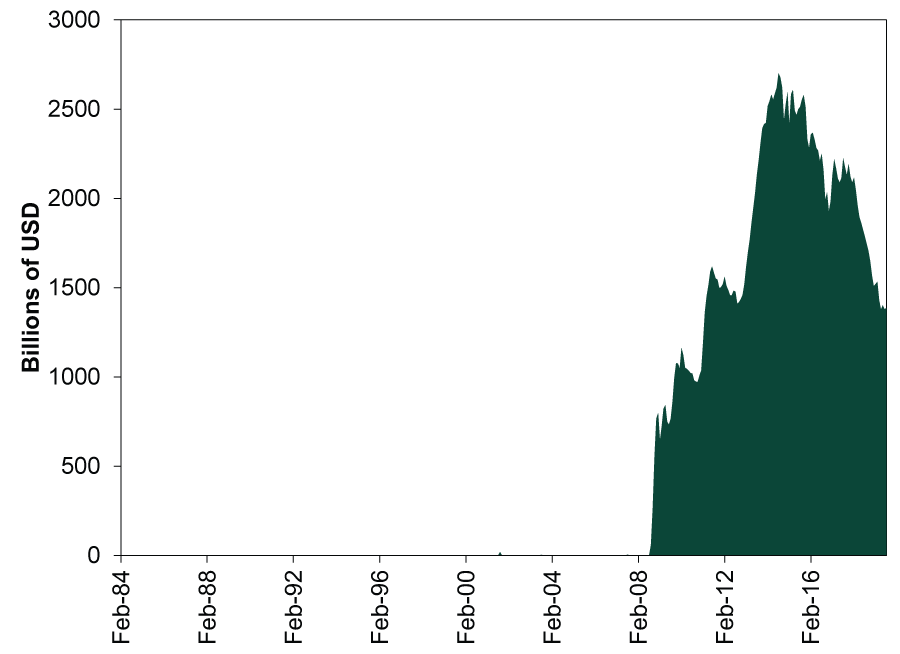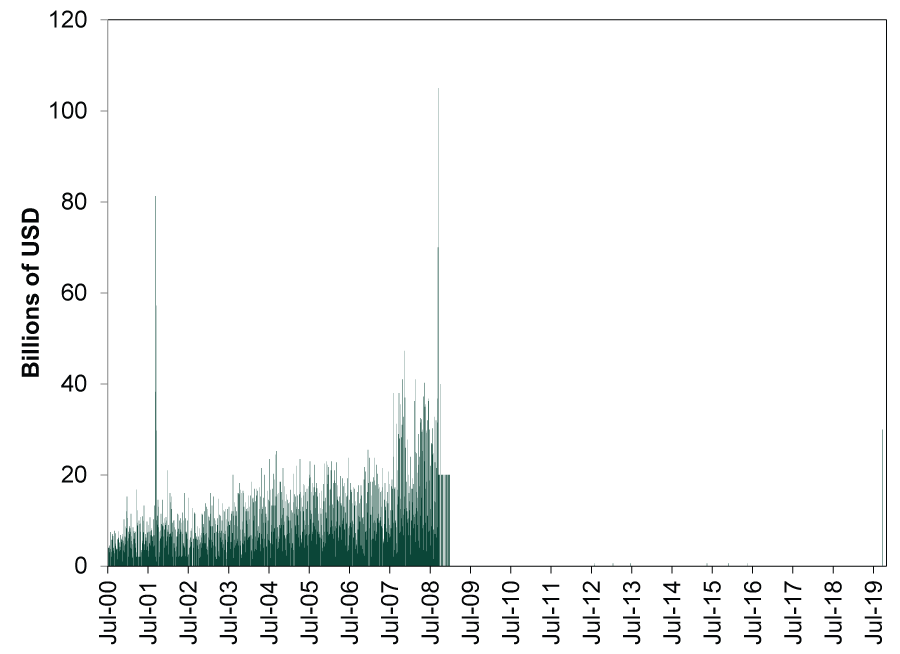Personal Wealth Management / Market Volatility
Everything You Never Wanted to Know About the Repo Market
We swear we tried to make this approachable and interesting.
Last week, one largely undiscussed-yet-important area of the US financial system experienced unusual volatility—triggering an ocean of jargon incomprehensible to most. It is a significant challenge, but here we aim to cut through all of that and provide you a readable, lay-speak discussion of what happened in the repurchase agreement (repo) market. Trigger warning: This is dry stuff! We will make every effort to make this generally readable and weave in a joke or two as a palate cleanser. Overall, our takeaway is this: Last week’s swings seemingly stem from a combination of small technical factors the Fed didn’t anticipate and responded to at a lag. However, those factors aside, last week’s action wasn’t terribly abnormal and doesn’t seem like a prelude to broader problems ahead.
Before we go any further, it behooves all of us to get on the same page about what the repo market is. It goes straight to the basic functioning of banks in most market economies. Banks are required to hold a certain amount of money for each dollar they lend or trade—called a reserve requirement. To keep the math simple, imagine the reserve requirement is 10%. That means banks must hold $1 in reserve for every $9 lent.
Occasionally, banks dip below the minimum. This is not abnormal! It is not a sign of a looming crisis! It may be as simple as folks withdrawing more money than banks anticipated, putting them briefly under the requirement. After all, banks facilitate hundreds of millions of transactions daily. No one can have perfect expectations of how much money will flow in and out daily.
The entire banking system operates with this in mind. If a bank falls below the minimum temporarily, it must then get its hands on more cash to hold in reserve. There are lots of ways it could do this, but among the fastest is the repo market. Now, this is where most discussions of the repo market generally start reading like paragraphs typed entirely in wingdings.[i] Stay with us!
Here is how the repo market works: Bank ABC needs reserves for a very short period until its reserves rebound above required levels. So it aims to borrow very short term (think: overnight or a week). Bank ABC could seek an unsecured loan from another bank with excess reserves in the fed-funds market. It could tap the Fed directly via its discount window, although this is generally reserved for banks that are in trouble—thus, it is generally frowned upon. Or it can tap investors like money-market mutual funds in the repo market. Using bonds like Treasurys as collateral, Bank ABC enters a loan contract with an investor or institution with extra cash on hand. That contract generally fixes a very small interest rate and states that Bank ABC will repay the loan and get its bonds back upon expiration of the contract. That is the repurchase the market is named for. Are you still awake? Anybody? Hello?
If you are still awake, grab a cup of coffee and we will cover last week’s events.
Because these transactions are so closely related to the fed-funds market, the US overnight repo rate typically tracks the fed-funds rate. Yet early last week—while nearly everyone was anticipating Wednesday’s 0.25 percentage point Fed rate cut—the repo rate shot higher. On Monday, it jumped to around 2.9% intraday—above the top end of the fed-funds target range. Tuesday, it shot up more—hitting as high as 6% intraday before closing at 3.4%. Exhibit 1 illustrates the overnight repo rate’s tendency to mirror the fed-funds target rate and last week’s unusual jump (using closing yields).
Exhibit 1: Repo’s Unusual Jump

Source: FactSet, as of 9/25/2019. US overnight repo rate and fed-funds target (upper limit), 9/24/2017 – 9/24/2019.
Spiking rates like this can signal that demand for cash is exceeding supply. But this isn’t necessarily a sign of broader trouble. Astute readers may notice some similar-yet-smaller spikes at points in the past. These typically cluster around quarter end, as corporations close the books. That seems to be one contributing factor in the current go-round, too, as corporate tax payments were due on Monday. Those are big outflows from money funds that may otherwise enter into repo contracts with banks.
Further, the Japanese market was closed for a holiday, implying a major source of funding wasn’t active in the market. Finally, the US government sold bonds early last week, which may have further drained cash from money funds and other liquidity sources. These are the technical factors pundits generally argue were behind the move—and those seem more or less correct to us. In response to this, the Fed stepped in as a source of liquidity, pushing rates back down toward the target by last Friday.
Beyond these technical factors, Fed policy also seems like a contributory factor. For years, the Fed hasn’t had to intervene in the repo market like this, as the banking system was awash in excess reserves. (Exhibit 2)
Exhibit 2: Excess Reserves Boomed During QE

Source: Federal Reserve Bank of St. Louis, as of 9/25/2019. Excess reserves, February 1984 – August 2019 (full data series).
These excess reserves stemmed from the Fed’s quantitative easing (QE) bond purchases and zero interest rate policy. When the Fed bought massive quantities of long-term bonds from banks under QE, it lowered long rates. Banks borrow short term to fund long-term loans. As a result, the gap between the two is a proxy for loan profitability. With short rates pinned near zero, lowering long rates made lending less profitable—an incentive for banks to hold cash. Further, the central bank began paying interest on excess reserves in 2008. These two factors are likely why US banks massively increased excess reserves post-QE.
Because excess reserves jumped so much, the repo market was flooded with cash. Hence, the Fed hasn’t had to intervene since 2008. But before then, such interventions were commonplace. (Exhibit 3) As Fed head Jerome Powell[ii] put it last year, the bank went from “actively” managing reserves pre-crisis to “passively” doing so post-crisis.
Exhibit 3: Fed Intervention in the Repo Market Is Old Hat

Source: Federal Reserve Bank of St. Louis, as of 9/25/2019.
But since 2014, the combination of the Fed’s tiny (and now stopped) QE unwind and rate hikes meant excess reserves were falling. While they are still lofty by historical standards, they don’t seem to be distributed evenly across all US banks—larger banks have the lion’s share. Yet they also have regulatory requirements to hold more high-quality assets as a safety buffer—a factor making them less likely to offer cash reserves in the repo market.
It appears to us the Fed was caught a little flat-footed by this. It was essentially out of practice! But in the subsequent days, it has seemingly regained its poise and control over short-term funding markets. Now many talk about creating a permanent facility to intervene in the repo market. Which, to us, is a little weird seeing as how the Fed was that facility before 2008. In that way, this looks like a return to normal policy pre-financial crisis.
Anyway, that wraps up our ‘splainer of the repo market. If you find yourself having trouble sleeping at some point in the future, by all means think of repo and trot this article out. It is probably about as effective as Unisom without the nasty feeling the next day.
Hat Tip: Michael Weston, Aaron Anderson and Christo Barker.
[i] Example:
[ii] We resisted the urge to dub Powell “The Repo Man,” but will be ok if you want to do so.
If you would like to contact the editors responsible for this article, please message MarketMinder directly.
*The content contained in this article represents only the opinions and viewpoints of the Fisher Investments editorial staff.
Get a weekly roundup of our market insights
Sign up for our weekly e-mail newsletter.

You Imagine Your Future. We Help You Get There.
Are you ready to start your journey to a better financial future?

Where Might the Market Go Next?
Confidently tackle the market’s ups and downs with independent research and analysis that tells you where we think stocks are headed—and why.






